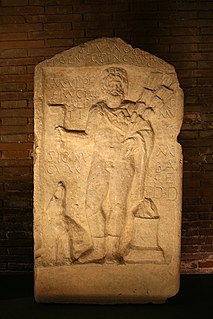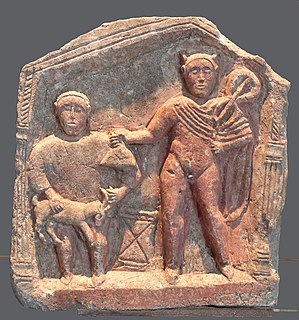
Mercury is a major god in Roman religion and mythology, being one of the 12 Dii Consentes within the ancient Roman pantheon. He is the god of financial gain, commerce, eloquence, messages, communication, travelers, boundaries, luck, trickery and thieves; he also serves as the guide of souls to the underworld. He was considered the son of Maia, who was a daughter of the Titan Atlas, and Jupiter in Roman mythology. His name is possibly related to the Latin word merx, mercari, and merces (wages); another possible connection is the Proto-Indo-European root merĝ- for "boundary, border" and Greek οὖρος, as the "keeper of boundaries," referring to his role as bridge between the upper and lower worlds. In his earliest forms, he appears to have been related to the Etruscan deity Turms; both gods share characteristics with the Greek god Hermes. He is often depicted holding the caduceus in his left hand. Similar to his Greek equivalent Hermes, he was awarded the caduceus by Apollo who handed him a magic wand, which later turned into the caduceus.

Asclepius or Hepius is a hero and god of medicine in ancient Greek religion and mythology. He is the son of Apollo. Asclepius represents the healing aspect of the medical arts; his daughters are Hygieia, Iaso, Aceso, Aegle, and Panacea. He was associated with the Roman/Etruscan god Vediovis and the Egyptian Imhotep. He was one of Apollo's sons, sharing with Apollo the epithet Paean. The rod of Asclepius, a snake-entwined staff, remains a symbol of medicine today. Those physicians and attendants who served this god were known as the Therapeutae of Asclepius.
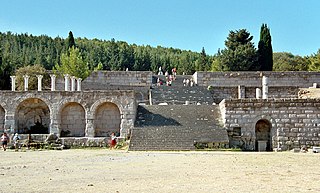
Asclepeions were healing temples located in ancient Greece, dedicated to Asclepius, the first doctor-demigod in Greek mythology. Asclepius was said to have been such a skilled doctor that he could even raise people from the dead. So stemming from the myth of his great healing powers, pilgrims would flock to temples built in his honor in order to seek spiritual and physical healing.
Belenus is a sun god from Celtic mythology and, in the 3rd century, the patron deity of the Italian city of Aquileia. Called the "Fair Shining One", he was one of the most ancient and most-widely worshiped Celtic deities and is associated with the ancient fire festival and modern Sabbat Beltane. He was associated with the horse and also the wheel. Perhaps like Apollo, with whom he became identified in the Augustan History, Belenos was thought to ride the sun across the sky in a horse-drawn chariot.

In the Celtic polytheism of classical antiquity, Grannus was a deity associated with spas, healing thermal and mineral springs, and the sun. He was regularly identified with Apollo as Apollo Grannus. He was frequently worshipped in conjunction with Sirona, and sometimes with Mars and other deities.

In Celtic polytheism, Sirona was a goddess worshipped predominantly in East Central Gaul and along the Danubian limes. A healing deity, she was associated with healing springs; her attributes were snakes and eggs. She was sometimes depicted with Apollo Grannus or Apollo Borvo. She was particularly worshipped by the Treveri in the Moselle Valley.

Nodens is a Celtic deity associated with healing, the sea, hunting and dogs. He was worshipped in ancient Britain, most notably in a temple complex at Lydney Park in Gloucestershire, and possibly also in Gaul. He is equated with the Roman gods Mars, Neptune and Silvanus, and his name is cognate with that of the Irish mythological figure Nuada and the Welsh Nudd.

In the practice of religion, a cult image is a human-made object that is venerated or worshipped for the deity, spirit or daemon that it embodies or represents. In several traditions, including the ancient religions of Egypt, Greece and Rome, and modern Hinduism, cult images in a temple may undergo a daily routine of being washed, dressed, and having food left for them. Processions outside the temple on special feast days are often a feature. Religious images cover a wider range of all types of images made with a religious purpose, subject, or connection. In many contexts "cult image" specifically means the most important image in a temple, kept in an inner space, as opposed to what may be many other images decorating the temple.
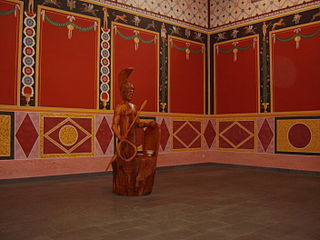
Lenus was a Celtic healing god worshipped mainly in eastern Gaul, where he was almost always identified with the Roman god Mars. He was an important god of the Treveri tribe, who had large sanctuaries at medicinal springs at Trier and the Martberg by Pommern in what is now Germany. Two dedications to him are also known from southwestern Britain. Edith Wightman characterizes him as “one of the best examples of a Teutates, or god of the people, equated with Mars—protector of the tribe in battle, but also [...] bestower of health and general good fortune” (p. 211). His sanctuary ‘Am Irminenwingert’ at Trier had a large temple, baths, smaller shrines and a theatre; that on the Martberg also included a large variety of buildings, probably including rooms for health-seeking pilgrims to stay. Despite his associations with healing, Lenus Mars is depicted classically as a warrior with Corinthian helmet in a bronze statuette from the Martberg.

Mullo is a Celtic god. He is known from inscriptions and is associated with the god Mars in the form of Mars Mullo.
Moritasgus is a Celtic epithet for a healing god found in four inscriptions at Alesia. In two inscriptions, he is identified with the Greco-Roman god Apollo. His consort was the goddess Damona.
Ianuaria is a Celtic goddess revered at the Burgundian sanctuary of Beire-le-chatel, a spring shrine at which images of Apollo, triple-horned bulls and doves were also dedicated. A small stone statuette from the temple depicts a young girl with curly hair, clad in a heavy-pleated coat and holding a set of pan-pipes. On the base of the statue is inscribed 'Deae Ianuariae'. Nothing else is known about this goddess. She may have been a healing goddess: the spring was a healing shrine, and it is known that Ianuaria's companion god Apollo was a healing god in both Celtic and Classical contexts. It is also possible that, since Apollo was a patron of music, and the goddess was depicted as holding panpipes, she was a goddess of music, which was perhaps perceived as a means of inducing the healing sleep.
Moccus is a Celtic god who was equated with Mercury. He is the boar/pig/swine god of the continental Celtic Lingones tribe. Moccus was invoked as the protector of boar hunters, and warriors. Boar meat was sacred, and eaten in ritual feasts. The Lingones whose tribal center was at Langres were a continental Celtic-Germanic tribe located in the Seine and Marne rivers area of northeastern France, and were neighbors to the Germanic Treveri tribe. Another Lingones tribe was located near the mouth of the Po River in northeastern Italy, and were known for agriculture, weaving and metalworking.

In ancient Roman religion and myth, Mars was the god of war and also an agricultural guardian, a combination characteristic of early Rome. He was second in importance only to Jupiter and he was the most prominent of the military gods in the religion of the Roman army. Most of his festivals were held in March, the month named for him, and in October, which began the season for military campaigning and ended the season for farming.
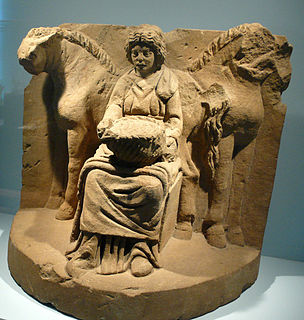
The gods and goddesses of the pre-Christian Celtic peoples are known from a variety of sources, including ancient places of worship, statues, engravings, cult objects and place or personal names. The ancient Celts appear to have had a pantheon of deities comparable to others in Indo-European religion, each linked to aspects of life and the natural world. By a process of synthesism, after the Roman conquest of Celtic areas, these became associated with their Roman equivalent, and their worship continued until Christianization. Ancient Celtic art produced few images of deities, and these are hard to identify, lacking inscriptions, but in the post-conquest period many more images were made, some with inscriptions naming the deity. Most of the specific information we have therefore comes from Latin writers and the archaeology of the post-conquest period. More tentatively, links can be made between ancient Celtic deities and figures in early medieval Irish and Welsh literature, although all this was produced well after Christianization.

Nettleton is a village and civil parish about 6.5 miles (10.5 km) northwest of Chippenham in Wiltshire, England. The parish includes the villages of Burton and West Kington, and the hamlets of Horsedown, Nettleton Shrub and West Kington Wick. The northern section of Nettleton village is known as Nettleton Green.
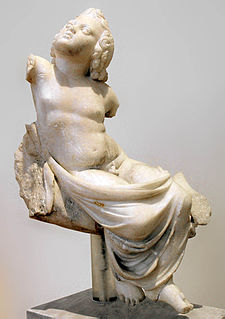
A ploutonion is a sanctuary specially dedicated to the ancient Greek and Roman god Pluto. Only a few such shrines are known from classical sources, usually at locations that produce poisonous emissions and were considered to represent an entrance to the underworld.

A Romano-Celtic temple is a sub-class of Roman temple found in the north-western provinces of the Roman Empire. Many may have had roots in the late Iron Age either in direct relation to pre-Roman structures or on sites with pre-Roman activity.



